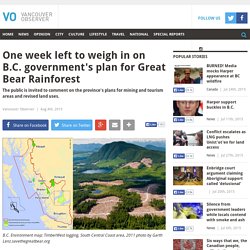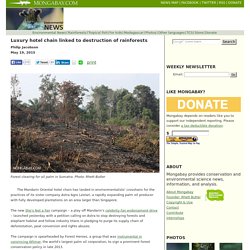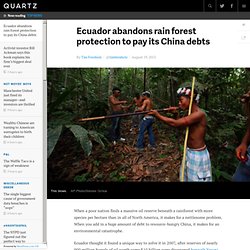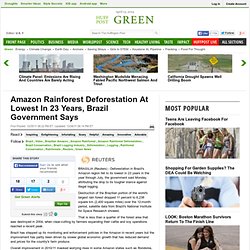

Vancouver Observer sur Twitter : "One week left to weigh in on B.C. government's plan for Great Bear #Rainforest @ForestEthics. One week left to weigh in on B.C. government's plan for Great Bear Rainforest. The public review and comment period on the B.C. government's proposed land use changes in the Great Bear Rainforest closes next Monday, Aug. 10.

Comments are sought on the potential for new biodiversity, mining and tourism areas (BMTAs) and a conservancy and revised land use objectives. The intent of the proposed Great Bear Rainforest land use order and potential BMTAs and conservancy is to meet the goals of reserving 70 per cent of historic old-growth forests (with minor exceptions), while maintaining a viable forest industry in the Great Bear Rainforest. The Great Bear Rainforest covers 6.4 million hectares on B.C.'s north and central coast. According to a government press release, the proposed land use order addresses First Nations cultural heritage resources, freshwater ecosystems and habitats, landscape and stand level biodiversity and bear habitat. The potential BMTAs being considered are Hanson, Sonora, King and Gil Islands, and the Kitsault, Kimsquit, Green and Braden areas.
Luxury hotel chain linked to destruction of rainforests. Forest clearing for oil palm in Sumatra.

Photo: Rhett Butler The Mandarin Oriental hotel chain has landed in environmentalists' crosshairs for the practices of its sister company Astra Agro Lestari, a rapidly expanding palm oil producer with fully developed plantations on an area larger than Singapore. The new She's Not a Fan campaign – a play off Mandarin's celebrity-fan endorsement drive – launched yesterday with a petition calling on Astra to stop destroying forests and elephant habitat and follow industry titans in pledging to purge its supply chain of deforestation, peat conversion and rights abuses. The campaign is spearheaded by Forest Heroes, a group that was instrumental in convincing Wlimar, the world's largest palm oil corporation, to sign a prominent forest conservation policy in late 2013. Both Mandarin and Astra are ultimately owned by Jardine Matheson, one of the 200 largest publicy traded companies in the world and controlled by the Scottish Keswick family.
Video by iquitoz. Instagram. Company accused of logging endangered rainforest trees in breach of timber legality certificate. APRIL partner accused of clearing forests and felling endangered tropical hardwoods.

Indonesian NGO says the wood supplier is linked to corruption and its legal timber certificate should be revoked. Controversial palm oil project approved in Cameroon rainforest. Ecuador Stops Protecting Its Rainforest—to Pay Off Debt to China - Tim Fernholz. When a poor nation finds a massive oil reserve beneath a rainforest with more species per hectare than in all of North America, it makes for a nettlesome problem.

When you add in a huge amount of debt to resource-hungry China, it makes for an environmental catastrophe. Ecuador thought it found a unique way to solve it in 2007, after reserves of nearly 900 million barrels of oil worth some $10 billion were discovered beneath Yasuni national park, a world biological preserve home to several indigenous groups. Cut Down Rain Forests, Lose Your Rain. Ulva Island rain forest in New Zealand.

It’s clear that cutting down rain forests to plant crops, however fulfilling in the short-term for a farmer, is a disaster for the millions of species living there. But it could also, in the long term, be a disaster for the farmer. A recent study in Nature combines rainfall data, satellite images showing tree cover, and atmospheric modeling to show that air that has passed over tropical forests often carries at least twice as much water as air that’s passed over less leafy land.
That means that large-scale cutting of rain forests can result in catastrophic drought for hundreds of miles around. Tropical trees act as enormous water pumps, drawing gallons and gallons of water up from deep in the soil. Key mammals dying off in rainforest fragments. New research shows that the lowland tapir is nearly extinct in the Atlantic Forest.

Photo by: Jeremy Hance. When the Portuguese first arrived on the shores of what is now Brazil, a massive forest waited for them. Not the Amazon, but the Atlantic Forest, stretching for over 1.2 million kilometers. Here jaguars, the continent's apex predator, stalked peccaries, while tapirs waded in rivers and giant anteaters unearthed termites mounds.
Converting palm oil companies from forest destroyers into forest protectors. This may be true in some cases, particularly when stands of commercial timber-rich forest are granted for palm oil. But times may be changing. In collaboration with the Prince’s Rainforests Project and agricultural economist Thomas Fairhurst, we recently interviewed a number palm oil companies in Indonesia about the value to them of expanding into land with tree cover vs. expanding into areas without trees. Many stated they would rather expand onto non-forested land due to the set-up costs and the lengthy bureaucratic processes of getting a permit in forested areas. None of the companies interviewed cited financing—and thus the need for a timber cut to generate cash—as a factor restricting their expansion. Rather, they emphasized the importance of improved spatial planning as the main requirement to reach oil palm development targets as well as forest conservation goals in Indonesia.
If communities are to be compensated for providing degraded land to companies, who will pay them? Fonterra climate crimes: The true price of Fonterra milk. The carbon footprint of New Zealand milk could be much larger than Fonterra claims.

A new report released today reveals that Fonterra’s continued use of palm kernel expeller (PKE) as a supplementary feed on dairy farms could have produced up to 8.9 million tonnes of greenhouse gas emissions. That’s the equivalent to 12 per cent of New Zealand’s entire annual greenhouse gas emissions. Titled ‘The carbon cost of palm kernel expeller from Malaysia and Indonesia’ this is the first fully transparent report produced on the carbon footprint created by PKE. Last year, a record breaking 1.4 million tonnes of palm product, which is currently unsustainably produced, was imported in to New Zealand to feed Fonterra’s industrial dairying operation.
The huge carbon footprint of palm kernel is due to the well-documented destruction of both rainforests and carbon rich peatlands in Indonesia and Malaysia by the palm industry. Amazon Rainforest Deforestation At Lowest In 23 Years, Brazil Government Says. BRASILIA (Reuters) - Deforestation in Brazil's Amazon region fell to its lowest in 23 years in the year through July, the government said Monday, attributing the drop to its tougher stance against illegal logging.

Destruction of the Brazilian portion of the world's largest rain forest dropped 11 percent to 6,238 square km (2,400 square miles) over the 12-month period, satellite data from Brazil's National Institute for Space Research showed. That is less than a quarter of the forest area that was destroyed in 2004, when clear-cutting by farmers expanding their cattle and soy operations reached a recent peak. Brazil has stepped up its monitoring and enforcement policies in the Amazon in recent years but the improvement has partly been driven by slower global economic growth that has reduced demand and prices for the country's farm produce. Overall improvement in 2010/11 masked worrying rises in some Amazon states such as Rondonia, where deforestation doubled from the previous year.
Soy moratorium in Amazon maintaining its effectiveness. The moratorium on clearing Amazon rainforest for soy farms in Brazil appears to be maintaining its effectiveness for a fifth straight year, reports the Brazilian Association of Vegetable Oil Industries (ABIOVE). Forest monitoring undertaken by ABIOVE found soy on 11,698 hectares of forest land deforested after July 2006, the cut-off date for the moratorium. By comparison, some 4.2 million hectares of forest were cleared across the Amazon biome during the same period. Charts: deforestation in Indonesia and Malaysia, 2000-2010. Chart: Percent forest cover change in Indonesia and Malaysia between 2000 and 2010. Background satellite image courtesy of Google Earth, design by mongabay.com. Click image to enlarge. Indonesia and Malaysia lost more than 11 million hectares (42,470 square miles) of forest between 2000 and 2010, according to a study published last year in the journal Global Change Biology.
The area is roughly the size of Denmark or the state of Virginia. The bulk of forest loss occurred in lowland forests, which declined by 7.8 million hectares or 11 percent on 2000 cover. The study also broke down changes in forest cover by island.